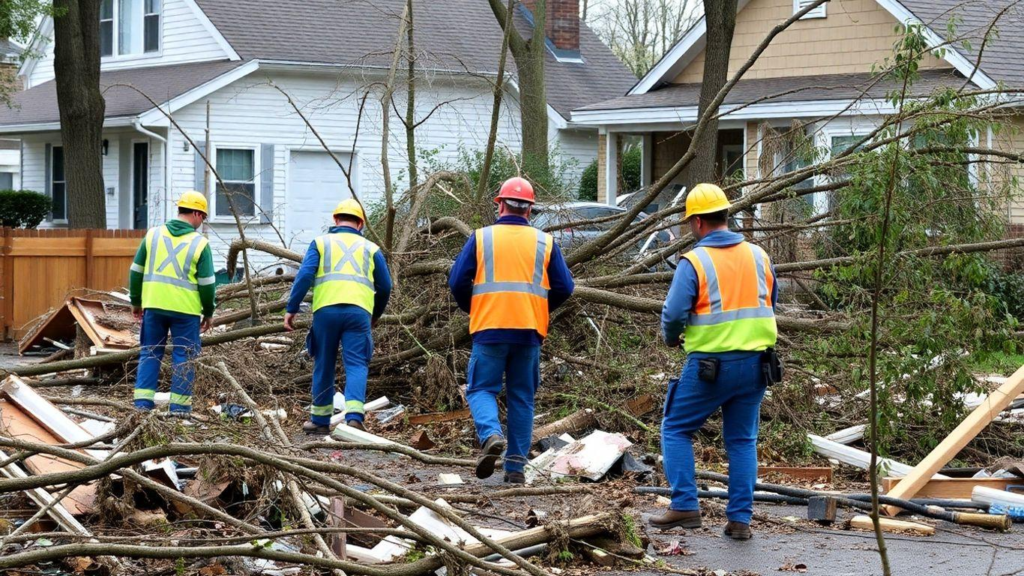Why Fast Storm Cleanup Is Essential for Safety and Recovery
When a storm hits, the immediate aftermath is a critical period. Getting things back to normal quickly isn’t just about convenience; it’s about safety and preventing bigger problems down the line. This means focusing on a few key areas right away to make sure everyone is safe and that the damage doesn’t get worse.
Clearing Emergency Access Routes
The first priority after a storm is clearing pathways. Blocked roads and driveways can stop emergency services from reaching those who need help. It also prevents residents from getting out if they need to evacuate. Clearing these routes quickly allows first responders and utility crews to get where they need to go without delay. This step is vital for any kind of rescue or repair work to even begin.
Securing Utility Infrastructure
Damaged power lines, gas leaks, and downed communication cables are serious hazards. Before any other cleanup can happen, these need to be identified and made safe. Securing utility infrastructure is paramount to prevent electrocution, fires, or further damage to the surrounding area. Professionals must assess these risks and work with utility companies to shut off or repair damaged lines. This protects both cleanup crews and the public.
Assessing Structural Integrity
Buildings that have taken a hit from a storm might look okay on the outside, but their internal structure could be compromised. High winds, heavy rain, or falling debris can weaken walls, roofs, and foundations. A quick assessment of structural integrity is needed to know if a building is safe to enter or if it poses a risk of collapse. This evaluation helps decide the next steps for repair or if temporary supports are needed to prevent further deterioration. This immediate attention to structural integrity is a key part of storm damage restoration.
Mitigating Further Damage and Health Risks
When storms hit, the damage doesn’t always stop when the wind dies down. Left unchecked, storm damage can quickly lead to a cascade of new problems, impacting both property and people. Acting fast is key to preventing these secondary issues from taking hold.
Preventing Mold and Structural Deterioration
Water is a storm’s unwelcome guest, and where it lingers, mold can quickly follow. Within just 24 to 48 hours of water exposure, mold spores can start to grow, especially in damp, dark places. This isn’t just unsightly; mold can damage building materials and, more importantly, release spores into the air that cause respiratory problems and allergic reactions. Beyond mold, standing water and saturated materials can weaken the structural integrity of buildings. Wood can rot, drywall can sag, and even the foundation can be compromised over time. This means that what might have been a manageable repair job can turn into a much larger, more expensive structural overhaul if not addressed promptly. Quick water extraction and drying are vital to stop mold and structural deterioration before they become major concerns.
Reducing Exposure to Hazardous Materials
Storms can tear apart homes and businesses, often exposing occupants and cleanup crews to hidden dangers. Think about damaged electrical wiring sparking, ruptured gas lines, or even contaminated floodwaters carrying bacteria and chemicals. These hazards pose immediate risks, from electrical shock and fire to serious health issues. Without a rapid response, these dangerous conditions can persist, making the affected area unsafe for anyone to enter. Professionals trained in storm cleanup know how to identify and safely handle these hazardous materials, minimizing the risk of injury or illness during the restoration process. Their swift action helps create a safer environment for everyone involved.
Minimizing Secondary Damage
Secondary damage is what happens when the initial storm damage isn’t dealt with quickly. It’s like a domino effect. For instance, a damaged roof might let in rain, which then causes interior water damage, leading to mold, and potentially weakening the ceiling joists. Each of these issues compounds the original problem, making the overall restoration effort more complex and costly. The longer materials remain wet or exposed, the more they degrade. This is why a rapid response team is so important; they work to contain the damage, remove water, and secure the property to prevent these secondary problems from escalating. This proactive approach saves time, money, and a lot of headaches down the line.
Enhancing Community Safety and Well-being
When storms hit, the immediate aftermath can feel chaotic. Streets blocked by fallen trees and debris aren’t just inconvenient; they’re a constant, visible reminder of the disruption, which can really ramp up anxiety for everyone. Getting things cleared quickly helps dial down that stress and brings back a sense of order much faster. It’s about more than just tidying up; it’s about restoring peace of mind.
Preventing Accidents and Injuries
Storm debris, especially fallen trees and branches, creates a minefield of hazards. These aren’t just eyesores; they’re tripping hazards, potential projectiles in high winds, and can obscure dangers like downed power lines or unstable ground. Prompt removal is key to preventing injuries. Think about kids playing or people trying to get around their neighborhood – a clear path means a safer path. Swift action in clearing storm-damaged trees directly reduces the risk of accidents and injuries in the community.
Restoring Order and Reducing Anxiety
Beyond the physical mess, uncleared storm damage can really mess with people’s heads. Seeing your street blocked by a downed tree or your yard full of branches is a constant visual cue that things aren’t right. This can prolong feelings of unease and helplessness. Quick cleanup operations help to erase these visual reminders, making it easier for residents to feel like life is getting back to normal. It’s a big step in calming nerves and getting rid of that lingering storm anxiety.
Boosting Community Morale
Storms can be tough on everyone, shaking up daily routines and damaging property. When people see that cleanup is happening fast, it sends a powerful message: we’re taking action, we’re recovering. This visible effort can really lift spirits. It reinforces the idea that people are looking out for each other and their shared spaces. Seeing progress, like storm-damaged trees being removed, can be incredibly empowering, especially when people might feel a bit lost or overwhelmed.
The social benefits of quick storm cleanup are often overlooked but are just as important as the physical restoration. A community that sees rapid action is a community that feels supported and resilient.
- Clearer Pathways: Roads and sidewalks become safe and accessible again.
- Reduced Hazard Zones: Dangers from falling debris or unstable structures are minimized.
- Visible Progress: Seeing cleanup efforts underway boosts confidence and reduces stress.
The Professional Approach to Storm Damage Restoration Near Me
When it comes to dealing with the aftermath of a storm, especially when it involves significant debris like fallen trees, calling in the pros makes a huge difference. They’ve got the right gear and the know-how to get the job done safely and efficiently. This isn’t a DIY situation for most people; it requires specialized equipment and a systematic approach to clear everything up without causing more problems. Their efficiency means less disruption for you and your neighbors, helping to restore a sense of normalcy much quicker.
- Specialized Equipment: Professionals use heavy machinery and tools designed for large-scale debris removal.
- Expertise: Trained crews know how to handle hazardous materials and unstable structures safely.
- Efficiency: They can clear large areas much faster than individuals, minimizing downtime.
Specialized Equipment and Expertise
Dealing with storm damage, particularly large fallen trees or structural issues, requires more than just a chainsaw and a pickup truck. Professionals come equipped with heavy-duty machinery like cranes, chippers, and specialized trucks capable of hauling away massive amounts of debris. Their teams are trained in safety protocols for working around downed power lines, unstable structures, and hazardous materials. This specialized knowledge means they can tackle complex situations that would be dangerous or impossible for the average homeowner to handle. Their expertise is what allows for safe and effective storm cleanup.
Efficient Debris Removal Strategies
One of the biggest challenges after a storm is simply getting rid of all the mess. Professionals have developed strategies to make this process as quick as possible. This often involves sorting debris on-site, using industrial chippers to reduce the volume of wood, and coordinating with local landfills or recycling centers. They understand the logistics of moving large quantities of material efficiently, which significantly speeds up the restoration process. This systematic approach to debris removal is vital for reopening roads and restoring access.
Systematic Restoration Procedures
After the initial debris removal, the work isn’t over. Professionals follow a structured process to assess and address remaining damage. This might involve temporary structural stabilization, water extraction, and thorough drying to prevent mold. They work methodically, addressing the most critical issues first to prevent further deterioration. This systematic approach ensures that all aspects of the damage are considered, leading to a more complete and lasting restoration. It’s this organized method that helps communities bounce back faster.
Accelerating Economic Recovery Post-Storm
Storms can really mess with a town’s money. When roads are blocked and businesses can’t open, it’s a big hit to the local economy. Getting things cleared up fast means shops can start selling again and people can get back to work. This quick action helps the economic recovery get going much sooner.
Swift cleanup is key to getting businesses back on their feet. It’s not just about getting back to normal; it’s about preventing longer-term financial problems for everyone. The faster things are back to how they were, the less money is lost overall. This is true for small shops and larger companies alike.
When a community bounces back quickly, it also looks better to outside help. This can mean getting disaster relief funds faster. These funds can help rebuild and make things stronger for the future, which is a win-win for the town’s finances.
Resuming Local Business Operations
When storm debris blocks streets and sidewalks, it’s tough for businesses. Customers can’t get to them, and deliveries might not arrive. Clearing these routes quickly is the first step to getting sales back up. It shows the community is open for business.
Think about a local restaurant. If people can’t get to it because of fallen trees, they lose money every hour it’s inaccessible. Getting those trees moved and the area safe means the doors can open again. This rapid return to normal operations is vital for survival.
The faster businesses can reopen, the less financial damage they suffer. This directly impacts jobs and the overall health of the local economy.
Attracting Disaster Relief Funding
Communities that show they are organized and acting fast after a storm are often viewed more favorably when applying for disaster relief. A well-managed cleanup effort demonstrates preparedness and a commitment to recovery.
Government agencies and private foundations look for signs of effective response. Prompt action can make the difference between receiving substantial aid or facing delays. This funding is critical for rebuilding infrastructure and supporting residents.
- Demonstrate organized response efforts.
- Show efficient use of local resources.
- Provide clear documentation of damage and cleanup progress.
Maintaining Property Values
After a storm, damaged properties and debris can make a neighborhood look run-down. This can cause property values to drop, which affects homeowners and the local tax base. Cleaning up quickly helps keep the area looking good.
When homes and businesses are repaired and landscaping is restored promptly, the area remains attractive. This stability in property values is important for long-term economic health. It reassures residents and potential buyers that the community is resilient.
| Property Type | Pre-Storm Value (Est.) | Post-Storm Value (Est. w/ Delayed Cleanup) | Post-Storm Value (Est. w/ Rapid Cleanup) |
| Residential | $300,000 | $240,000 | $290,000 |
| Commercial | $1,000,000 | $700,000 | $950,000 |
This table shows how a quick cleanup can help maintain property values, preventing significant financial loss for owners and the community.
Environmental Preservation Through Swift Action
Storms can really mess with nature. When trees and other plants get damaged, it’s not just about how things look. It’s about the whole environment. Acting fast after a storm helps protect local wildlife and keeps our water clean. It’s a big part of getting things back to normal, not just for people, but for the planet too.
Protecting Local Wildlife Habitats
When trees fall or get broken during a storm, they can really disrupt animal homes. Birds might lose their nests, and small animals can lose their shelter. If we don’t clear this debris quickly, it makes it hard for wildlife to find safe places to live and raise their young. Swift action in storm cleanup helps restore these natural habitats so animals can get back to their routines. It also clears the way for new growth, which is good for the future of the ecosystem.
Preventing Water Source Contamination
Storms can wash all sorts of things into our rivers, lakes, and even groundwater. Debris, chemicals, and soil can all end up where we get our drinking water. If we don’t clean up quickly, these contaminants can stick around and make the water unsafe. Getting rid of storm debris fast is key to stopping this pollution. It means our water sources stay cleaner and healthier for everyone.
Promoting Healthier Tree Growth
Damaged trees are like open wounds. They’re more likely to get sick or attract pests. If we leave broken branches or fallen trees lying around, diseases can spread to other healthy trees nearby. Cleaning up storm damage quickly means we can treat injured trees or remove ones that are too far gone. This helps prevent the spread of sickness and gives the remaining trees a better chance to recover and grow strong. It’s all about giving the environment a helping hand after it’s been through a rough time.
The Professional Approach to Storm Damage Restoration Near Me

When storms hit, the aftermath can be overwhelming. Dealing with debris, damaged structures, and potential hazards requires more than just a quick fix. This is where professional storm damage restoration services become indispensable. These teams bring specialized equipment and a systematic approach to tackle the chaos left behind by severe weather.
Swift and safe cleanup is paramount after a storm. Professionals understand the urgency and possess the know-how to handle the situation efficiently. They follow strict safety protocols, especially when dealing with downed power lines or unstable buildings. Their goal is to not only clear the mess but to do so in a way that prevents further harm and sets the stage for a complete recovery. Relying on their expertise means you can rest easier knowing the job is being handled correctly.
Choosing a professional for storm damage restoration near me means you’re opting for a team trained to identify and mitigate risks. They have the tools and knowledge to manage everything from large fallen trees to hazardous material containment. This methodical process helps restore order and safety much faster than DIY attempts, allowing communities to begin rebuilding sooner.
The Takeaway: Act Fast for a Safer Tomorrow
When the winds die down and the rain stops, the real work begins. Clearing storm debris isn’t just about making things look tidy again; it’s a serious job that impacts safety, speeds up recovery, and even helps the environment and local economy bounce back. Getting roads clear so emergency crews can get through, preventing mold from taking hold in damaged buildings, and removing hazards like downed power lines are all top priorities. Plus, seeing a community cleaned up quickly helps everyone feel a bit more hopeful. So, while it might seem like just a lot of work, fast storm cleanup is a really important step in getting back to normal and building a stronger, safer place for everyone.







